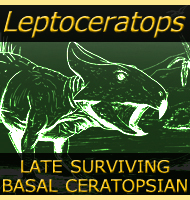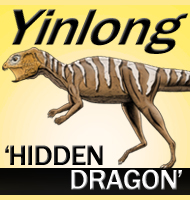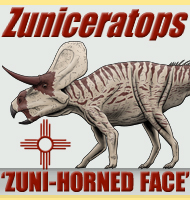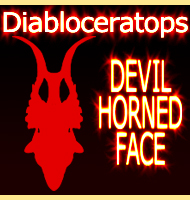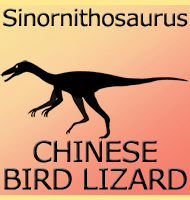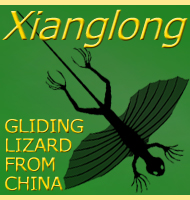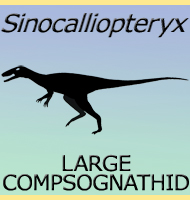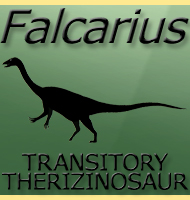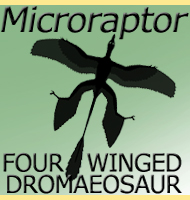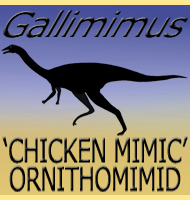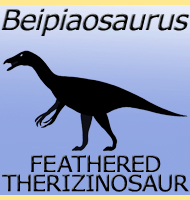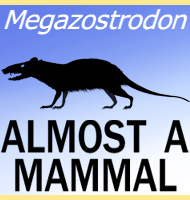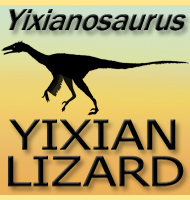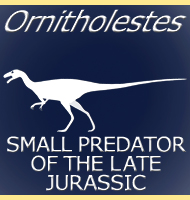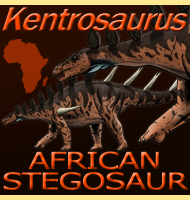


Psittacosaurus
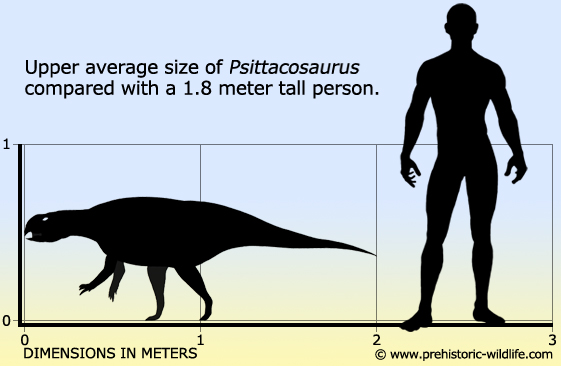
Name:
Psittacosaurus
(Parrot lizard).
Phonetic: Sit-tah-coe-sore-us (The ‘P’ is silent and
is not pronounced).
Named By: Henry Fairfield Osborn - 1923.
Synonyms: Protiguanodon, Luanpingosaurus.
Classification: Chordata, Reptilia, Dinosauria,
Ornithischia, Ceratopsia, Psittacosauridae.
Species: P. mongoliensis (type), P.
amitabha, P.
gobiensis, P. lujiatunensis, P. major, P. mazongshanensis, P.
meileyingensis, P. neimongoliensis, P. ordosensis, P. sibiricus, P.
sinensis. P. xinjiangensis.
Diet: Herbivore.
Size: Up to about 2 meters long.
Known locations: China, Mongolia and Russia.
Possibly also Thailand.
Time period: Barremian through to the Albian of the
Cretaceous.
Fossil representation: Multiple individuals.
When it comes to the study of ceratopsian dinosaurs, it is the genus Psittacosaurus that has the most significance. The remains of literally over four hundred individuals are known, a few of these complete, articulated and with soft tissue remains such as skin and feather impressions. It is also possible to study the entire lifespan of Psittacosaurus with the remains of numerous juvenile individuals from hatchlings to sub adults also in a high state of preservation. In addition to all this, at the time of writing Psittacosaurus has the largest number of species attributed to it that any other dinosaur genus.
Psittacosaurus
lived during the early Cretaceous, and because fossils of
Psittacosaurus are so numerous and only known from
this period, the
genus has now become established as a biochron. What this means is
that when scientists discover Psittacosaurus
remains, they can be
confident that they are dealing with an early Cretaceous aged deposit.
Because of its appearance in the early Cretaceous and display of
primitive features, Psittacosaurus is considered
to be one of the
most primitive ceratopsians we know about, and a likely reflection of
the distant ancestors of later, larger and more famous ceratopsian
dinosaurs such as Triceratops
and Styracosaurus.
Psittacosaurus
seems to have averaged about two meters in length, with some species
such as P. lujiatunensis and P.
sibiricus being the largest at just
over two meters long, while P. ordosensis is
the smallest
established species with a length of under one and a half meters long.
Species of Psittacosaurus are usually
differentiated by the shape of
the skull, particularly differences in length, height,
roundness, as well as additional features such as bony lumps.
We
need to be clear that although Psittacosaurus was a
ceratopsian
dinosaur, it lacked the elaborate horns and neck frills that are
commonly seen in later relatives. Some species are noted for having
bony lumps growing from their skulls which may have been analogous to
the horns of later relatives, but this is the exception of the
species, not the rule of the genus.
Psittacosaurus
had teeth that were adapted for slicing through plants, and their
arrangement and wear patterns show that they sharpened themselves.
Because Psittacosaurus were unable to grind food
in the mouth, they
are thought to have used gastroliths to grind food in the stomach,
and some Psittacosaurus have been found with
rounded stones within
what would have been there stomachs in life. The lower jaw of
Psittacosaurus seems to have been capable of a
sliding action that
would have aided shearing of tough plants. It has been speculated
that Psittacosaurus were probably selective
browsers with a preference
for certain plant parts including but not limited to parts such as
seeds. A seed rich diet would also support the need for gastroliths
since shearing teeth would not be suited to dealing with things like
seeds.
The
posture of Psittacosaurus has been interpreted as
being quadrupedal
when juvenile, steadily shifting to primarily, perhaps obligatory
bipedal in adult life. It has been proven that the fore arms of
adults could not rotate, provide forward spring, or even
realistically reach the ground, all strong evidence that adult
Psittacosaurus were bipedal.
There
is some evidence that proves that at least some species of
Psittacosaurus had a row of quill like feathers that
ran down from the
pelvis to the tail. These quills would have been of little use in
either insulation of defence, but they would have been very good
structures for display. In terms of scales, Psittacosaurus
seem to
have had patterns of larger scales surrounded by smaller one, a type
of arrangement that has also been seen in some other later and more
advanced ceratopsian dinosaurs.
There
are at least two known discoveries of several juvenile Psittacosaurus
that had been preserved together. What is interesting about this
concentration though is that the juveniles were of different ages which
has led to the idea that juvenile Psittacosaurus
would congregate
together into groups, perhaps to give them better protection from
predators. One collection of Psittacosaurus
juveniles (DNHM D2156)
was once claimed to be proof of parental care in Psittacosaurus
because the skull of what seemed to be an adult Psittacosaurus
was
found with them. However a later study (Zhao, 2013) discovered
two problems with this interpretation. One was that the ‘adult’
skull was actually from an individual that was six years old at the
time of death, and study of other Psittacosaurus
fossils has shown
that Psittacosaurus did not reach reproductive
maturity until ten years
of age. Two, the ‘adult’ skull was found to have been glued to
the slab with the juveniles upon it and bore no evidence whatsoever of
belonging to the rock that the juveniles belonged to.
The
realisation that the more adult skull had been added by someone who no
doubt wanted to increase its saleability to a collector, there is
know no direct evidence that Psittacosaurus cared
for their young.
This does not disprove the idea for parental care entirely, it still
may have happened, but there is no fossil evidence that proves it,
and that’s the key thing about interpreting behaviour for long
extinct animals, proof. Despite the vast amount of fossils for
Psittacosaurus, there is still much that we could
potentially learn
about Psittacosaurus behaviour, yet on the flip
side to that we might
never find out anything else. But some later genera of ceratopsian
dinosaurs have been found in vast bone bed concentrations that contain
the remains of hundreds, perhaps even thousands of individuals that
died together in the same location in a short space of time,
indicating that at least some later ceratopsians lived in groups. It
is conceivable that Psittacosaurus may have
travelled around in
groups, even if only in loose concentrations building up where food
was most abundant.
As
far as predators for Psittacosaurus go the obvious
choice of potential
threats would be from the dinosaurs that were roaming around at the
time, perhaps particularly dromaeosaurids,
small theropods that
were very fast and with the perfect adaptations for taking down small
orntihischian dinosaurs like Psittacosaurus. Prehistoric
crocodiles
could have also been a threat, especially when you consider that
they came in a great many more diverse forms in the early Cretaceous.
Most significantly though was the discovery of a triconodont mammal
named Repenomamus
robustus that had the remains of a small juvenile
Psittacosaurus within what would have been its
stomach. This juvenile
Psittacosaurus was preserved in articulated chunks
which means that
after the Repenomamus caught the Psittacosaurus
it pulled it apart
and swallowed it in chunks. This was the first discovery of a mammal
eating a dinosaur and is undeniable evidence that by the early
Cretaceous the mammals had evolved to a point that they were capable of
hunting smaller dinosaurs.
Further reading
- Juvenile specimens of the ornithischian dinosaur Psittacosaurus.
-
Palaeontology 25: 89–107. - Walter P. Coombs - 1982.
- Psittacosaurus meileyingensis (Ornithischia:
Ceratopsia), a new
psittacosaur from the Lower Cretaceous of northeastern China. - Journal
of Vertebrate Paleontology 8: 366–377. - Paul C. Sereno, Zhao Xijin,
Chang Zhengwu & Rao Chenggang - 1988.
- Psittacosaurus xinjiangensis (Ornithischia:
Ceratopsia), a new
psittacosaur from the Lower Cretaceous of northwestern China. - Journal
of Vertebrate Paleontology 8: 353–365. - Paul C. Sereno & Zhao
Xijin - 1988.
- A new species of the ornithischian dinosaur Psittacosaurus
from the
Early Cretaceous of Thailand. - Palaeontology 35: 801–812. - Eric
Buffetaut & Varavudh Suteethorn 1992.
- New psittacosaur occurrences in Inner Mongolia. - Canadian Journal of
Earth Sciences 33: 637–648. - Dale A. Russell & Zhao Xijin -
1996.
- Psittacosaur fossils and their stratigraphical implications. In: Wang
Y. & Deng T. (Eds.). - Proceedings of the Seventh Annual
Meeting of the Chinese Society of Vertebrate Paleontology. Beijing:
China Ocean Press. Pp. 75–80. - Xu Xing & Zhao Xijin - 1999.
- Growth curve of Psittacosaurus mongoliensis
Osborn (Ceratopsia:
Psittacosauridae) inferred from long bone histology. - Zoological
Journal of the Linnean Society 130: 551–566. - Gregory M. Erickson
& Tatyana A. Tumanova - 2000.
- The occurrence of Psittacosaurus xinjiangensis
Sereno and Chao, 1988
in the Urho area, Junggar basin, Xinjiang. - Canadian Journal of Earth
Sciences 38: 1781–1786. - Donald B. Brinkman, David A. Eberth, M. J.
Ryan & Chen Peiji - 2001.
- Bristle-like integumentary structures at the tail of the horned
dinosaur Psittacosaurus. Naturwissenschaften 89:
361–365. - Gerald
Mayr, Stephan D. Peters, Vogel Herhard & Olaf Gerhard - 2002.
- Remarks on Psittacosaurus sattayaraki Buffetaut
& Suteethorn,
1992, a ceratopsian dinosaur from the Lower Cretaceous of Thailand. -
Oryctos 4: 71–73. - Eric Buffetaut & Varavudh Suteethorn - 2002.
- Parental care in an ornithischian dinosaur. - Nature 431: 145–146. -
Meng Qingjin, Liu Jinyuan, David J. Varrichio, Timothy Huang &
Gao Chunling - 2004.
- Large Mesozoic mammals fed on dinosaurs. - Nature 433: 149–152. - Hu
Yaoming, Meng Jin, Wang Yuanqing & Li Chuankui - 2005.
- A new species of Psittacosaurus (Dinosauria:
Ceratopsia) from the
Early Cretaceous Yixian Formation, Liaoning, China. - Palaeoworld 15:
100–114. - Zhou Changfu, Gao Keqin, Richard C. Fox & Chen
Shuihua - 2006.
- A ceratopsian dinosaur Psittacosaurus sibiricus
from the Early
Cretaceous of West Siberia, Russia and its phylogenetic relationships.
- Journal of Systematic Paleontology 4(4): 359–395. - Alexander O.
Averianov, Alexei V. Voronkevich, Sergei V. Leshchinskiy &
Alexei V. Fayngertz - 2006.
- The Psittacosaurus biochron, Early Cretaceous of
Asia. - Cretaceous
Research 27: 189–198. - Spencer G. Lucas - 2006.
- Analysis of forelimb function in basal ceratopsians. - Journal of
Zoology 273: 305–314. - P. Senter - 2007.
- Social behaviour and mass mortality in the basal ceratopsian dinosaur
Psittacosaurus (Early Cretaceous, People's Republic
of China). -
Palaeontology 50(5): 1023–1029 -Q. Zhao, P. M. Barret & D. A.
Eberth - 2007.
- A new Psittacosaurus (Dinosauria: Ceratopsia)
specimen from the
Yixian Formation of western Liaoning, China: the first pathological
psittacosaurid. - Cretaceous Research - Kobayashi L� Junchang, Lee
Yuong-Nam Yoshitsugu & Ji Qiang - 2007.
- New psittacosaurid highlights skull enlargement in horned dinosaurs.
- Acta Palaeontologica Polonica 52(2): 275–284. - Paul C. Sereno, Zhao
Xijin, Loren Brown & Tan Lin - 2007.
- New data on cranial anatomy of the ceratopsian dinosaur
Psittacosaurus major. - Acta Palaeontologica
Polonica 53(2):183–196. -
Hai-Lu You, Kyo Tanoue & Peter Dodson - 2008.
- A new psittacosaur from Inner Mongolia and the parrot-like structure
and function of the psittacosaur skull. - Proceedings of the Royal
Society B 277(1679):199–209. - Paul C. Sereno, Zhao Xijin & Tan
Lin - 2010.
- Juvenile-only clusters and the behaviour of the Early Cretaceous
dinosaur Psittacosaurus. - Acta Palaeontologica
Polonica. - Q. Zhao, M.
J. Benton, X. Xu & M. J. Sander - 2012.
- Lujiatun Psittacosaurids: Understanding Individual and Taphonomic
Variation Using 3D Geometric Morphometrics. - In Evans, Alistair
Robert. PLoS ONE 8 (8) - B. P. Hedrick & P. Dodson - 2013.
- Histology and postural change during the growth of the ceratopsian
dinosaur Psittacosaurus lujiatunensis. - Nature
Communications - Qi
Zhao, Michael J. Benton, Corwin Sullivan, P. Martin Sander &
Xing Xu - 2013.
- Juvenile-only clusters and behaviour of the Early Cretaceous dinosaur
Psittacosaurus. - Acta Palaeontologica Polonica - Q.
Zhao - 2013.
- The osteology and taphonomy of a Psittacosaurus bonebed assemblage of
the Yixian Formation (Lower Cretaceous), Liaoning, China. - Cretaceous
Research. 51: 321–340. - Brandon P.Hedrick. Gao Chunling, Gomaa I.Omar,
Zhang Fengjiao, Shen Caizhi & Peter Dodson - 2014.
- Juvenile-only clusters and the behaviour of the Early Cretaceous
dinosaur Psittacosaurus. - Acta Palaeontologica
Polonica. 59 (4):
827–833. - Qi Zhao, Michael J. Benton, Xing Xu & P. Martin
Sander - 2014.
- 3D Camouflage in an Ornithischian Dinosaur. - Current Biology. 26
(18): 2456–2462. - Jakob Vinther, Robert Nicholls, Stephan
Lautenschlager, Michael Pittman, Thomas G. Kaye, Emily Rayfield, Gerald
Mayr & Innes C. Cuthill - 2016.
- Structure and homology of Psittacosaurus tail
bristles. -
Palaeontology. 59 (6): 793–802. - Gerald Mayr, Michael Pittman, Evan
Saitta, Thomas Kaye & Jakob Vinther - 2016.
- A crocodylian-style cloaca in a non-avialan dinosaur. - P. R. Bell,
M. Pittman, T. G. Kaye & H. Hendrickx - 2020.
----------------------------------------------------------------------------
Random favourites
 |
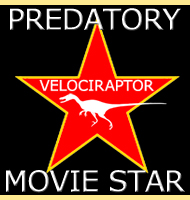 |
 |
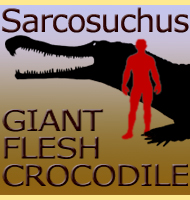 |
